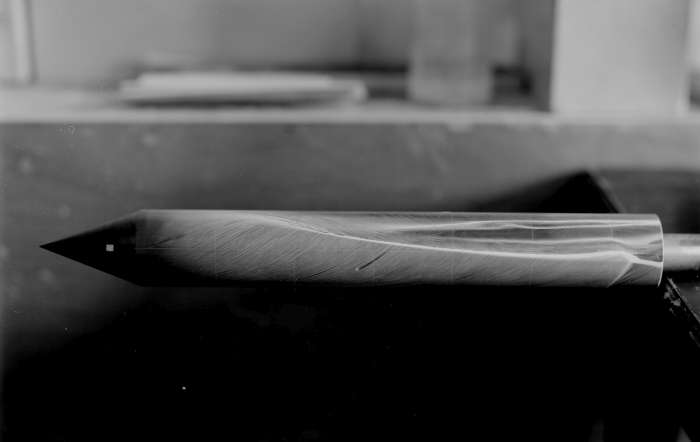
| Beeldbank van Stichting Behoud Erfgoed NLR (SBEN) |
|
|
|

Klik op bovenstaande afbeelding voor een 100% weergave |
|
| Database nr. | : | 00667 |
|---|---|---|
| Titel | : | Stroming rond cone-cilinder onder invalshoek bij supersone snelheden / The flow around a cone cylinder at angles of attack at supersonic speeds |
| Instituut | : | NLR |
| Locatie | : | Amsterdam, Schinkel Industrieterrein |
| Datering | : | 1970-1971 |
| Bijzonderheden | : | De stroming rond een cone-cilinder onder invalshoek – vooral bij supersone snelheden - een groot raadsel. En dat was nog een simpel model. Er kon gerekend worden, maar de betrouwbaarheid liet meer dan te wensen over. De complicaties waren - om er een paar te noemen: -De windsnelheid (subsoon, transsoon, supersoon), met zijn compressibiliteit, -De neusvorm (punt, afronding), -De invalshoek, -De stromingsloslating, zie het model, -Secundaire schokgolven -Subsone-supersone gebieden, -Instationaire fenomenen, vooral aan de lijzijde bij invalshoek. -Ontstaan van wervels. De stroming rond een eenvoudig cone-cilinder-model en met name bij de overgang cone naar cilinder werd als een van de eerste onderzocht. Dat deed men natuurlijk eerst via eenvoudige drukkenmetingen. Daarna begon men te rekenen en te vergelijken met meetdata. Het hier getoonde model moest – voor een specifieke modelvorm, invalshoek en snelheid - de oppervlaktestroming illustreren. En dan speciaal de loslaatlijn van de omstroming. Het benodigde experimentele werk werd ook op het NLR gedaan. Dit model was beplakt met afneembaar cellofaan en met een olie/krijtmengsel bespoten. Het eindpatroon van de stroming kon worden opgemeten en ingebracht in de berekening. Ook op dit gebied is door het NLR baanbrekend werk verricht. Er werd niet alleen uitvoerig gemeten, maar ook jarenlang gerekend en gepubliceerd. En zeker toen later soortgelijke problemen zich voordeden bij deltavleugels. The flow around a cone cylinder at angles – especially at supersonic speeds – is a big mystery. And that still was a simple model. It was possible to calculate, but the reliability left more than desired. The complications were - to name a few: -The wind speed (subsonic, transsonic, supersonic), with its compressibility; -The nose shape (tip, rounding); -The angle of attack; -The flow detachment, see the model; -Secondary shock waves; -Subsonic/supersonic areas; -Instationary phenomena, especially on the wear side at angles of attack; -Formation of vortices. The flow around a simple cone-cylinder model and especially at the transition cone into cylinder was one of the first investigated. Of course, this was done first via simple pressure measurements. After that, they started calculating and comparing with measurement data. The model shown here had to illustrate the surface flow for a specific model shape, angle of attack and speed. Especially the release line of the flow. The necessary experimental work was also done at NLR. This model was covered with removable cellophane, and sprayed with an oil/chalk mixture. The end pattern of the flow could be measured and inserted into the calculation. Groundbreaking work has also been carried out by NLR in this area. Not only there were extensive measurements, but also years of calculation and publishing. And especially when similar problems later occurred with delta wings. |
| Fotograaf | : | |
| Collectienaam | : | |
| Rubriek | : | Aerodynamica |
| Subrubriek | : | Aerodynamische studies |
| Categorie | : | Foto: z/w |
| Achterkant afbeelding | : | |
| Afmetingen | : | L=13cm, B=18cm |
| Rapportnummer | : | |
|
|
||
Record aangepast: 10 mei 2021